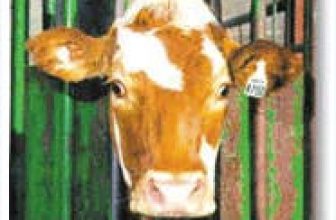
Application case analysis of radio frequency identification technology in animal management of animal husbandry
[ad_1]
In the past 10 years or so, animal epidemics around the world have continued to break out, which has severely hit the animal husbandry in the world, especially in Europe, and has attracted great attention from countries in the world, especially in Europe, prompting governments to quickly formulate policies and adopt various measures. measure. For this reason, all countries in the world have strengthened the management of animals in animal husbandry and commerce. Among them, the identification and tracking of animals has become one of the major measures adopted by all countries. For example, the British government stipulates that all kinds of tracking and identification methods must be adopted for breeding animals such as cattle, pigs, sheep, goats, and horses.

1. Recognition and tracking of animals
Animal identification and tracking refers to a technology that uses specific tags to correspond to the animal to be identified by a certain technical means, and can track and manage the relevant attributes of the animal at any time.
The identification and tracking of various animals can strengthen the control and supervision of foreign animal diseases, protect the safety of local species and ensure the safety of international trade of livestock products; it can strengthen the government’s animal vaccination and disease prevention management, and improve the management of animals. Disease diagnosis and reporting capabilities, as well as emergency response to domestic and foreign animal epidemics. Therefore, the identification and tracking management of animals is not only a requirement of the animal husbandry, but also a national government act and an international act. The following describes the identification and tracking of cattle, pigs and sheep.
Recognition and tracking of cattle
Currently, a tracking system for cattle has been established in Europe. In September 1998, the United Kingdom announced plans for a cattle tracking system. At the end of 1999, all member states of the European Community implemented this system plan.
The British government stipulates that cattle born or imported after July 1, 2000 must be digitally identified. The identification and registration of cattle include identification, farm records and permits. The identification label must be installed within 20 days after the birth of the cow. The identification label has the identification code of the cow, and this identification code will accompany the life of the cow. The farm’s records contain all the information about the birth, import, activity and death of each cow. Every cow has a CTS license, which stores all records of the cow’s life. CTS is a computer system established in the UK to track and manage cattle. The British government pays for its establishment and the initial stage of use.
Identification and tracking of pigs
From November 1, 2003, the United Kingdom began to implement new pig identification standards. The new standard has different identification requirements for all pigs under + years of age sent directly to the slaughterhouse and pigs over one year old to any other destination.
Recognition and tracking of sheep
From January 1, 2008, European regulations have compulsory electronic identification of sheep. In order to verify the performance of the electronic identification system, Delta will start real-time electronic identification and digital transmission experiments in a real environment in March 2004. Farmers, ranches and slaughterhouses will choose different electronic identification systems. The test is scheduled to end in March 2005, and a report will be submitted in June of the same year.
In addition, the British government also stipulated that starting from June 30, 2004, all horses must be identified and tracked.
Currently, widely used animal identification methods include: ear tags, back tags, necklaces, tail tags, freeze prints, tattoos, lacquer tags, and leg tags. The practice of animal electronic identification in recent years has shown that among the electronic identification methods, Radio Frequency IdenTIficaTIon (RFID) plays an increasingly important role in animal management.
2. RFID technology of radio frequency identification
Radio frequency identification is a non-contact automatic identification technology, which has the characteristics of large data storage, readable and writable, strong penetrating power, long reading and writing distance, fast reading speed, long service life, and good environmental adaptability. And it is the only automatic recognition technology that can realize multi-target recognition.
RFID consists of a reader and an electronic tag (Tag). Attach the electronic tag to the surface or inside of the identified object (such as an animal). When the identified object (such as an animal) enters the recognition range of the reader, the reader will automatically read the object in the electronic tag (such as Animal) identification data, so as to realize the function of automatically identifying objects (such as animals) or automatically collecting information and data of objects (such as animals).
(1) Reader
The RFID reader is composed of modules such as control system, communication interface, microstrip antenna and power supply. Handheld reader (HR) is one of the readers, which is suitable for handheld use by mobile users, and its working principle is exactly the same as other readers. In addition to the modules that the general reader has, it can also have an LCD keyboard and a barcode scanning module. The communication interface of HR can be 802.11, RS323. The power supply of HR is powered by rechargeable batteries; the operating system can be WinCE or other operating systems; the data storage is 32MB flash memory, 32MB memory; the antenna is a built-in antenna or probe detector.
(2) Electronic label
The electronic tag is composed of modules such as data storage, data processing, communication interface, microstrip antenna and power supply. The electronic tag writes the ID code and the relevant information of the article. Electronic tags are divided into passive electronic tags and active electronic tags according to different power supply forms. The power supply of the passive electronic tag is obtained from the radio frequency signal sent by the reader, so the reader must have a higher transmission power and a shorter identification distance. Active electronic tags rely on their own micro-batteries to supply power, so the reader’s transmit power requirements are low, and the system’s identification distance is longer. Compared with active electronic tags, passive electronic tags have the advantages of low cost, no maintenance, high reliability and long life. In the identification and tracking of animals, in addition to the use of active electronic tags for special scientific research, most of them use passive electronic tags.
[ad_2]





